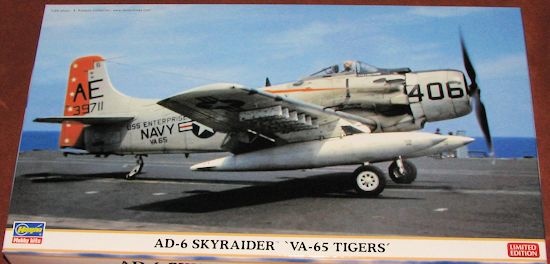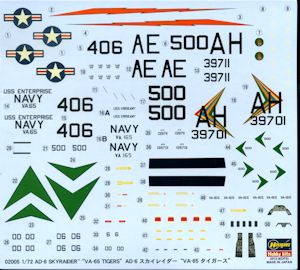
Hasegawa 1/72 AD-6 Skyraider 'VA-65 Tigers'
| KIT #: | 02005 |
| PRICE: | $25.00 on sale ($50.00 SRP) |
| DECALS: | Two options |
| REVIEWER: | Scott Van Aken |
| NOTES: |

| HISTORY |
The Douglas Skyraider, with its straight, low-mounted, tapered wings, was the only aircraft of its time capable of delivering 8,000 pounds of bombs with dive-bombing precision against such difficult targets as mountain bridges and hydroelectric dams. The AD-4B could deliver nuclear bombs using the "toss-bombing" or "over-the-shoulder" bombing technique.
The first AD-1 Skyraider was delivered in 1946 and named according to the Douglas tradition of starting the names of Navy aircraft with "sky." When the Navy, Marine Corps and Air Force numbering systems merged in 1962, the "AD" series Skyraiders were redesignated as "A" series aircraft.
Before production ceased in 1957, 12 years after the airplane was introduced, Douglas built 3,180 Skyraiders in 28 variations. These included carrier- or land-based airplanes, day or night attack bombers, and versions for photographic reconnaissance, electronic countermeasures, airborne early warning, utility and search missions.
Different configurations carried a pilot in an enclosed cockpit, a pilot and another person (either a radar operator or a co-pilot), and a pilot and two other crew. The AD/A-5 could carry a crew of four, plus four passengers or 12 troops, four stretchers, or 2,000 pounds of cargo.
During the Korean conflict, the Skyraiders entered service over the Korean Peninsula in October 1951, and by 1955, there were 29 Navy Skyraider squadrons on carriers.
In 1964, it was modified for service in the Vietnam War, redesignated A-1E/A-1H, and used by the U.S. Navy and the U.S. and South Vietnamese air forces. Because of its ability to carry large bomb loads, absorb heavy ground fire and fly for long periods at low altitude, the Skyraider was particularly suited for close-support missions. The type was also used by the French and some were later sold to Chad.
| THE KIT |
 Though
dated 1996, this kit is the most recent one done of the Skyraider. Previously,
Airfix, Fujimi, and Tsukuda all did the A-1, but this one eclipses those in
terms of detail. Molded in medium grey plastic and up to the usual standard of
Hasegawa with engraved panel lines, and the use of small poly caps to hold in
the prop. The cockpit is adequate with a seat, stick and control panel all
fitting into the cockpit tub. Decals are used for instruments. Judging from what
looks like a canvas cover over the area behind the cockpit, it seems this kit
has the Yankee extraction system, something that I'm pretty sure was was not
on either of the markings options.
Though
dated 1996, this kit is the most recent one done of the Skyraider. Previously,
Airfix, Fujimi, and Tsukuda all did the A-1, but this one eclipses those in
terms of detail. Molded in medium grey plastic and up to the usual standard of
Hasegawa with engraved panel lines, and the use of small poly caps to hold in
the prop. The cockpit is adequate with a seat, stick and control panel all
fitting into the cockpit tub. Decals are used for instruments. Judging from what
looks like a canvas cover over the area behind the cockpit, it seems this kit
has the Yankee extraction system, something that I'm pretty sure was was not
on either of the markings options.
There is a
nicely detailed engine and the proper engine cover that was spring loaded to be
closed when the engine was not running. This kept salt spray and other crud out.
Once the engine started up, airflow opened these so cooling air could enter. It
also looks like the kit has the right wheels, these being spoked. The usual mass
of weapons pylons are on the bottom of the wing. The kit provided a centerline
and two wing tanks. Along with this are four triple rocket launchers. Again, I'm
pretty sure these are USAF weapons and not what was carried by Navy Skyraiders.
You'll have to delve into one of
 the Hasegawa weapons sets for a decent load. As tempting as it is
to fill all the stations, you have to realize that rarely was this done as all
aircraft have to trade carrying capacity (which includes fuel) for range.
the Hasegawa weapons sets for a decent load. As tempting as it is
to fill all the stations, you have to realize that rarely was this done as all
aircraft have to trade carrying capacity (which includes fuel) for range.
Instructions are what one would expect after all these years from Hasegawa. They include Gunze and some FS 595 color references. Markings are for two planes. One is the box photo plane from VA-65 'Tigers' aboard the USS Enterprise. The modeler will need to paint the fin/rudder orange to match the lightning bolt decal. The other is the CAG bird from VA-165 aboard the USS Oriskany in 1962. Note that neither plane has the fin mounted anti-collision light so that should be sanded off. The decals are nicely printed and provide wing walk markings.
| CONCLUSIONS |
It looks to be a fine kit and I know that it was produced in several boxings, both USAF and USN. This is the 2012 boxing of this kit and shows that Hasegawa gave in to Boeing licensing lawyers, something that I'm sure added a dollar or more to each kit (not that Hasegawa kits are not already quite pricey).
November 2013
| REFERENCES |
Thanks to me for providing this preview kit for your added education.
If you would like your product reviewed fairly and fairly quickly, please contact the editor or see other details in the Note to Contributors.